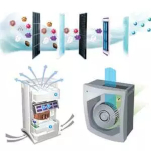
The air surrounding us contains health risks related to dangerous gases and highly fine particles. They can penetrate deep into our bloodstream by passing through our lungs’ alveoles. The smaller these impurities from polluted outdoor air are, the more they will be able to stick into our lungs.
The best way to get rid of these contaminants in the rooms of your home, especially old historic is by using an air purifier. These air cleaning devices do not just remove air contaminants, but they’re also beneficial to people with asthma and allergies, as well as reduce or eliminate the smell of tobacco in a room.
If you’re confused about the different types of air purifiers because of the jargons used in their brochures, this article will clear those out for you. Here you will find out essential information on the most common technologies utilized by air purifiers available in the market today including their pros and cons.

HEPA Technology
High-Efficiency Particulate Air or HEPA is a technology that was first introduced in the 1940s. These air filters are used by medical facilities and other technologically advanced industries because of their effectivity and reliability.
An air purifier with a HEPA air filter is 99.97% efficient at eliminating fine particles such as dust, pollen, and allergens for up to 0.3 microns. They also absorb bacteria and indoor air particles that can cause asthma and allergy symptoms. This will result in a fresh, clean, and little to no harmful contaminants air circulating in your home.
Pros:
- Eliminates common indoor allergens such as mold, dust mites, dust, pollens, some bacteria, and pet dander.
- Any air contaminants the was caught inside the filter will not re-circulate in the air.
- Does not produce any harmful or ozone byproducts.
Cons:
- Not capable of eliminating chemical fumes, gases, odors, tobacco smoke, and active organic compounds, as well as germs, viruses, and extremely small particles which are 0.01 microns or below.
- These type of filters work in a passive way which means that in order to draw in air which will trap the air contaminants, they need a fan.
- There’s a tendency for the trapped viruses and bacteria in the filter to reproduce or breed.
- Filter needs to be replaced regularly.
Depending on your concern, the best technologies that complement or best paired with HEPA filters are the following:
- Pre-filters. They capture larger particles, some are washable, and can extend the life of the filter. However, they require maintenance.
- Activated carbon. Can absorb chemicals, gases, and odors, and will leave your room smelling fresh. They can also get rid of pet and cigarette odors. They are expensive and heavy though.
- Ultraviolet light. Viruses, bacteria and other microorganisms are neutralized.

Activated Carbon Air Filter
Activated carbon filters can be obtained from coal, wood or shells. Its efficiency is increased by adding zeolite, potassium permanganate, and other elements which absorb odors, smoke, chemicals, and gases present in the air.
These filters have millions of pores where harmful gases and chemicals are trapped and neutralized. They can also provide relief from toxic fumes due to renovations, plastic off-gassing, and secondhand smoke. These filtering systems are effective and come with a material that can absorb chemicals which results in a cleaner air that smells fresh.
Pros:
- Because of its extreme absorbency, it’s efficient in trapping odors, gases, tobacco smoke, and chemical fumes.
- The contaminants it captures are not released back into the air.
- No harmful or ozone byproducts.
Cons:
- Not effective at removing allergens and dust.
- Not efficient at capturing viruses and bacteria.
- Works passively like HEPA filters.
- You need to replace the filters once they are filled with contaminants or they will lose their effectiveness.
The complementing technologies for this type are:
- HEPA air filter. This filtration system can capture any missed out particles and allergens by the activated carbon.
- UV light. It can eradicate the germs trapped by the activated carbon.
- Air Ionizer. The ions it will release can be utilized to get rid of contaminants proactively in the air.
Ultraviolet or UV Light Technology
UV light technology is great at neutralizing mold, viruses, bacteria, and germs. It is so effective that even the Centers for Disease Control recommends it. Often, it is used with particulate systems since it does not actually get rids of airborne particles.
Pros:
- Can eradicate fungi, viruses, germs, bacteria, and other microorganisms.
- Helps in preventing the spread of diseases and illnesses.
- It does not generate harmful and ozone byproducts.
Cons:
- It doesn’t have an effect on most dust, pollens, allergens and other particulates.
- Not capable of removing odors.
- It cannot get rid of cigarette smoke, chemical fumes, and gases.
You can complement this type or air purifiers with the following technologies:
- Air Ionizer and HEPA air filter. These two types can trap and eliminate allergens, dust, and other large particles not affected by the UV light.
- Activated carbon. It can get rid of the chemical fumes not affected by the UV light.
- Ozone generator. Your UV light will have the ability to remove odor when adding this technology.

Adding a few technologies will ensure that you’ll have the best air purifying device in your home. Your home will get the best result by utilizing the HEPA air purifier system. The performance of any filtration will not be ideal without it. Also, symptoms of asthma, allergies, and other pollution particles in your home, especially if it’s an old historic home, will not be reduced.